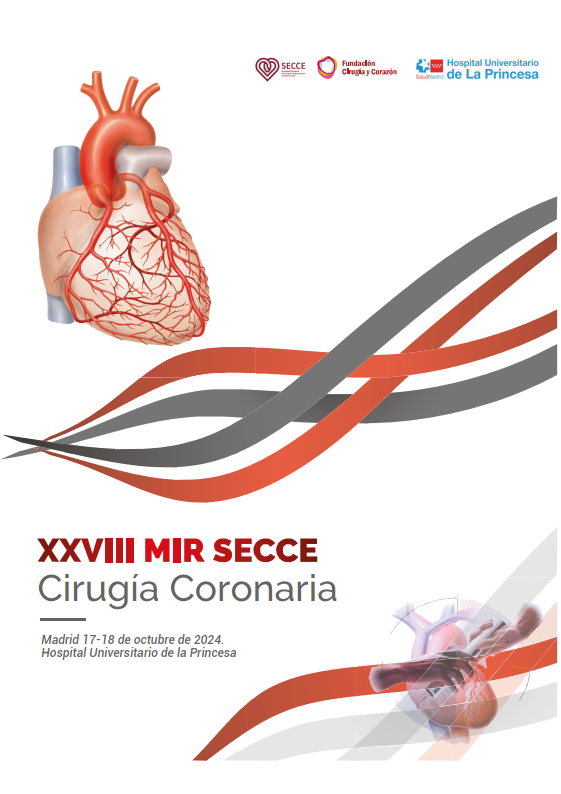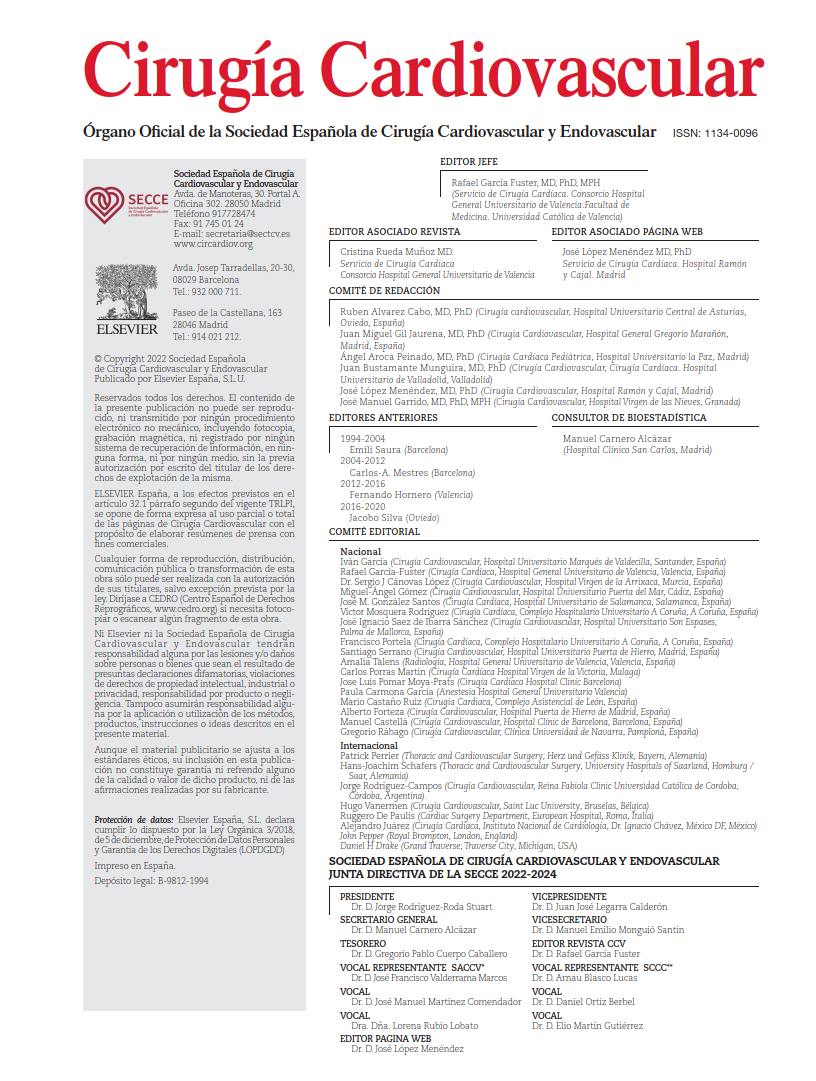In 1983, Alain Carpentier laid the groundwork for modern mitral valve repair with the publication of the functional classification of mitral regurgitation. Since then, numerous techniques have been developed to repair the mitral valve, always under the premise that preservation is preferable to replacement, and that the repair must achieve both an optimal and durable result.
The present study originates from Milan, specifically from San Raffaele Hospital—a renowned reference center for mitral valve repair, historically associated with the development of the edge-to-edge technique by Ottavio Alfieri. The cardiac surgery team from this high-volume Lombard center presents its long-term outcomes in a large cohort of patients undergoing mitral valve repair for degenerative disease. This retrospective analysis included 3,317 patients who underwent surgery between 2008 and 2017. Survival, reoperation, and heart failure rehospitalizations were assessed, the latter recorded through the Italian National Healthcare System, enabling nationwide capture of readmissions regardless of geographic location or institution.
In-hospital mortality was 0.48% for the entire cohort and 0.21% in patients undergoing isolated mitral valve repair. Ten-year survival was 89.6%, and 96.6% of patients remained free from reoperation. Risk factors for reintervention included anterior leaflet disease, the need for a second cardiopulmonary bypass (CPB) run, and more than mild mitral regurgitation at discharge. At 10 years, 92.2% of patients had not required readmission due to heart failure. When rehospitalization occurred, it was more common among patients with prior admissions or symptoms, or in those with anterior leaflet involvement. The authors concluded that isolated anterior leaflet disease was independently associated with an increased risk of reoperation, heart failure, rehospitalization, and mortality, compared with bileaflet or posterior leaflet disease.
COMMENTARY:
It is widely accepted that mitral valve repair represents the gold standard treatment for degenerative mitral regurgitation (MR). However, not all valves amenable to repair are actually repaired. Why? First, not all centers have the necessary expertise or sufficient case volume to sustain a repair-oriented philosophy. Second, the variety of available techniques and modifications described in the literature makes it difficult to establish a universal strategy. Third, certain aspects remain controversial—for instance, whether a complete annuloplasty ring is superior to a posterior band.
The results presented by the San Raffaele cardiac surgery team are outstanding. The study includes a substantial sample size and an enviable long-term follow-up (more than 3,000 patients with a median follow-up close to nine years). It could be considered a benchmark study, offering valuable insights for comparison across institutions worldwide and practical guidance for clinical decision-making.
The reported in-hospital mortality of 0.48% is excellent—lower than the 1.16% published in the STS database. However, it is important to note that the study population was low risk: the mean EuroSCORE II was below 1%, left ventricular ejection fraction (LVEF) averaged 60%, 90% of patients were in NYHA class I or II, and the mean age was relatively young (57 years). Interestingly, only 16% had atrial fibrillation, and concomitant procedures were performed in just 20% of cases—mostly tricuspid annuloplasty. These details suggest that preoperative atrial dimensions were likely not severely dilated (though echocardiographic data are not provided), and that clinical progression was generally limited before surgery.
The operations were performed by five different surgeons. While it is not explicitly stated whether all followed the same repair criteria, it is assumed that a consistent institutional philosophy was applied. Cardiopulmonary bypass and cross-clamp times were satisfactory—79 and 60 minutes, respectively. Reintervention for failed repair was necessary in only 5% of cases, which is commendable, although echocardiographic data on these patients are lacking. The most frequently involved leaflet was the posterior (71%), followed by bileaflet (20%) and anterior leaflet alone (9%).
In terms of surgical techniques, considerable variability was observed. Posterior leaflet resection was employed in 58.5% of cases, followed by edge-to-edge repair (26.6%) and PTFE neochordae implantation (11%). Notably, the edge-to-edge technique was used in one out of every four patients, which contrasts with the current trend favoring neochordae, aimed at restoring native leaflet coaptation while preserving leaflet integrity. Nevertheless, given that this is the institution where the technique was first developed, its widespread use reflects its surgical culture and legacy.
Several questions arise when analyzing these data. For example, if not all posterior leaflet pathologies were addressed with resection, what alternative strategies were employed in those cases? Moreover, if edge-to-edge repair was used in 26.6% of patients, yet only 20% had bileaflet disease, in what additional scenarios was the Alfieri stitch applied? What drives the selection of one technique over another? Is it primarily surgeon-dependent? In which cases were PTFE neochordae selected?
Some of these questions are addressed in the article’s supplementary material. For anterior leaflet disease, edge-to-edge repair was the most frequently performed technique (62.3%), followed by neochordae implantation (32.7%). Notably, PTFE neochordae were reserved for prolapse involving segment A3. In cases with isolated posterior leaflet pathology, resection was the dominant technique (87.6%). For P1 lesions, the Alfieri stitch was systematically used. In bileaflet disease, edge-to-edge repair was applied in 70% of patients—especially for A2-P2 involvement—while other anatomical variants were treated with more diverse techniques.
Thus, regarding posterior leaflet repair, the San Raffaele group continues to favor posterior leaflet resection in nearly 80% of cases. This approach contrasts with the widespread contemporary preference for neochordae implantation, which avoids leaflet resection and maintains tissue integrity. The use of neochordae in anterior prolapse was first described by Tirone David. Later, Patrick Perier demonstrated excellent results in posterior prolapse with a 10-year freedom from reoperation of 93%. More recently, David reported long-term outcomes using PTFE neochordae for anterior, posterior, and bileaflet prolapse with a unique technique involving multiple passes of the suture between the papillary muscle head and the free margin of the leaflet. Michael Borger, who follows a similar approach, recommends measuring the distance between the papillary muscle and the leaflet before finalizing chordal length. Hence, regarding posterior leaflet repair: is it better to resect or to respect? A recent comparative study found similar outcomes in terms of postoperative preservation of LV function. This remains a topic of interest. The San Raffaele team presents excellent outcomes, although the lack of detailed echocardiographic follow-up data somewhat limits interpretability.
Another relevant issue arises from the choice of annuloplasty: should a complete ring be used, or is a posterior band sufficient? Should the device be rigid or flexible? In this series, the Milan group opted for a posterior band in 96% of cases. Literature suggests that no significant differences in survival or repair durability exist between complete rings and posterior bands. Similarly, several authors have reported no outcome differences between rigid and flexible rings. In the present study, the choice appears to reflect individual surgeon preference rather than evidence-based criteria.
Finally, the reported rates of freedom from reoperation and heart failure rehospitalization—96% and 92%, respectively—are equally remarkable. Follow-up was comprehensive, enabled by centralized data collection through the Italian national health administration, which allowed tracking of all readmissions. However, once again, the absence of echocardiographic follow-up data precludes a more detailed analysis of failed repairs. For example, at discharge, 25% of patients had mild MR. It would have been valuable to know the preoperative MR grade and which repair technique was employed (were any of them reoperated?). The authors identified anterior leaflet disease as a risk factor for reoperation. Given this finding, it would have been informative to analyze which technique was applied in these patients. Were failures more frequent with neochordae or with the Alfieri stitch?
In summary, it is reasonable to conclude that excellent outcomes are typically achieved in high-volume centers where selected techniques—regardless of which ones—are applied consistently and systematically. More than forty years ago, Carpentier published his seminal article titled “The French Correction,” likely inspired by the 1971 film The French Connection. The team from San Raffaele could very well have titled their study, in homage to the 1969 movie, The Italian Job.
REFERENCES:
Del Forno B, Ascione G, Carino D, D’Ovidio M, Lapenna E, Verzini A, et al. Long-Term Outcomes of Contemporary Surgical Repair for Degenerative Mitral Regurgitation. J Am Coll Cardiol. 2025 Mar 4;85(8):835-847. doi: 10.1016/j.jacc.2024.10.108.
Carpentier A. Cardiac valve surgery–the “French correction”. J Thorac Cardiovasc Surg. 1983 Sep;86(3):323-37. PMID: 6887954.
Badhwar V, Chikwe J, Gillinov AM, Vemulapalli S, O’Gara PT, Mehaffey JH, et al. Risk of Surgical Mitral Valve Repair for Primary Mitral Regurgitation. J Am Coll Cardiol. 2023 Feb 21;81(7):636-648. doi: 10.1016/j.jacc.2022.11.017.
David TE. Replacement of Chordae Tendineae With Expanded Polytetrafluoroethylene Sutures. Ann Thorac Surg. 2025 Feb;119(2):259-262. doi: 10.1016/j.athoracsur.2024.12.001.
Perier P, Hohenberger W, Lakew F, Batz G, Urbanski P, Zacher M, et al. Toward a new paradigm for the reconstruction of posterior leaflet prolapse: midterm results of the “respect rather than resect” approach. Ann Thorac Surg. 2008 Sep;86(3):718-25; discussion 718-25. doi: 10.1016/j.athoracsur.2008.05.015.
David TE, David CM, Lafreniere-Roula M, Manlhiot C. Long-term outcomes of chordal replacement with expanded polytetrafluoroethylene sutures to repair mitral leaflet prolapse. J Thorac Cardiovasc Surg. 2020 Aug;160(2):385-394.e1. doi: 10.1016/j.jtcvs.2019.08.006.
Neely RC, Borger MA: Myxomatous mitral valve repair: Loop Neochord Technique. Oper Tech Thorac Cardiovasc Surg 20(2):106–123, 2015
van Wijngaarden AL, Tomšič A, Mertens BJA, Fortuni F, Delgado V, Bax JJ, et al. Mitral valve repair for isolated posterior mitral valve leaflet prolapse: The effect of respect and resect techniques on left ventricular function. J Thorac Cardiovasc Surg. 2022 Nov;164(5):1488-1497.e3. doi: 10.1016/j.jtcvs.2021.02.017.
Cetinkaya A, Waheed M, Bramlage K, Liakopoulos OJ, Zeriouh M, Hein S, et al. Comparison of flexible, open with semi-rigid, closed annuloplasty-rings for mitral valve repair. J Cardiothorac Surg. 2021 Mar 20;16(1):35. doi: 10.1186/s13019-021-01405-1.
Hu X, Zhao Q. Systematic evaluation of the flexible and rigid annuloplasty ring after mitral valve repair for mitral regurgitation. Eur J Cardiothorac Surg. 2011 Aug;40(2):480-7. doi: 10.1016/j.ejcts.2010.11.080.



